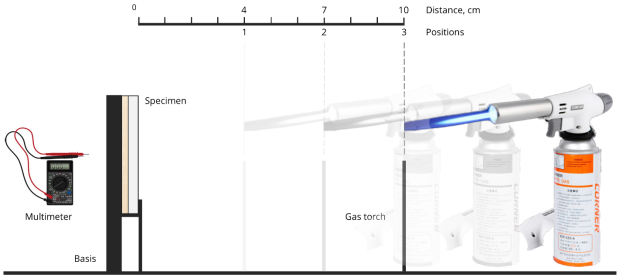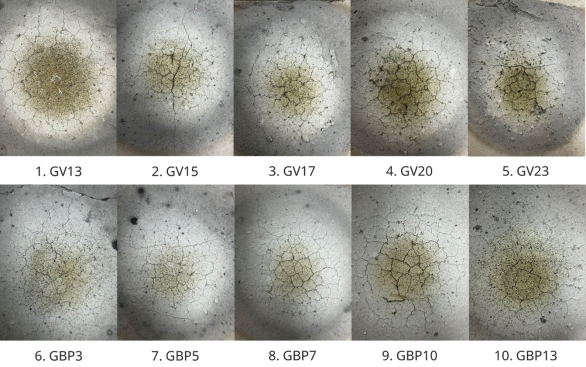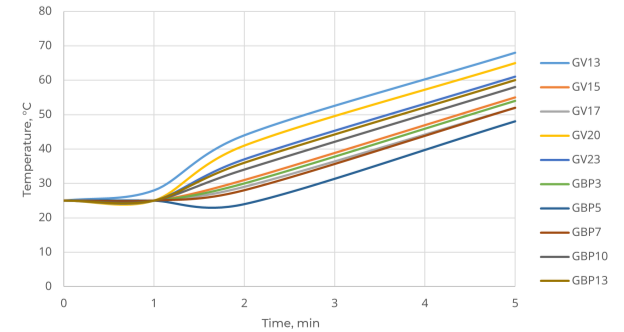This study investigates the development and properties of fire- and heat-protective dry building mixes utilizing gypsum binder. Gypsum-based materials offer versatility in construction applications, including heat preservation, thermal insulation, noise reduction, and fire resistance. The research explores the formulation of dry building mixes incorporating gypsum, expanded vermiculite, mineral fiber (basalt fiber), and brick waste powder to enhance fire resistance properties. Experimental analysis reveals significant improvements in fire resistance, structural stability, and thermal insulation with the optimized composition GBP5. The findings highlight the synergistic effects of additives and emphasize the importance of balancing fire resistance with structural integrity and thermal insulation in gypsum-based construction materials.
Keywords : gypsum, gypsum composition, gypsum binder, dry building mix, fire-resistant, fire retardant.
1. Introduction
Ensuring the maintenance of fire safety stands as a primary imperative within the realms of erecting and managing contemporary high-rise edifices, as well as commercial and industrial compounds. The manifestation of a fire event not only entails substantial pecuniary repercussions but also poses a grave peril to human life.
According to the Ministry of Emergency Situations of the Republic of Kazakhstan for January-December 2022 there were 12219 fires, the amount of damage was 36646407 thousand tenge. During the year 344 people died in fire, 314 suffered [1]. All this requires high requirements for the fire safety of buildings and structures, as well as the materials used in their structures.
The endeavour to increase the fire resistance of architectural structures through the use of effective fire-resistant materials remains relevant. Fire resistant plasters, impregnations, paints and coatings have been proposed as effective fire protection measures. However, some options entail significant costs, while others may not provide the required standard of fire resistance. This article is intended for the study of flame-retardant dry building mixes based on gypsum binder.
Gypsum is known to contain chemically bound water, which makes it particularly important in the context of its use as a fire resistant material. The process of heating gypsum leads to the release of chemically bound water, which is accompanied by the formation of gypsum hydrate and the evaporation of water vapour. This process, called gypsum dehydration, plays a key role in the fire resistance properties of this material. In addition, this phenomenon helps to reduce the expansion of the material when exposed to high temperatures, which prevents it from deforming and collapsing in a fire [2].
Gypsum and gypsum products serve many purposes and are not limited to: heat preservation, thermal insulation, noise reduction, fire resistance, etc. The disadvantages of gypsum are its low resistance to water and low frost resistance. Since gypsum-based products are porous and hygroscopic, gypsum is partially soluble in water [3]. This characteristic leads to a decrease in its resistance to water and frost [4].
2. Materials and methods
2.1 Materials
In the present study, G-2 grade gypsum binder was utilised and its characteristics are shown in Table 1.
Table 1
Characteristics of gypsum
|
Characteristics |
Gypsum binder |
|
Color |
White |
|
Bulk density, kg/m 3 |
900–940 |
|
Grain size, mm |
<0,2 |
|
Grain geometry |
Different |
|
Humidity, % |
<0,1 |
|
Clutch strength, MPa |
0,5 |
|
Compressive strength, MPa |
2,5 |
In the experiment, expanded vermiculite was used as a filler for dry building mix. Depending on the temperature and duration of processing, vermiculite can increase in size by 20–30 times compared to the original thickness. This expansion characteristic, attributed to the presence of interlayer water molecules within its crystalline structure, results in the formation of lightweight, accordion-like flakes, imparting vermiculite with exceptional insulating properties [5]. Such expansive behavior renders vermiculite a highly desirable additive in the formulation of fire- and heat-protective building materials. Its characteristics are shown in Table 2.
Table 2
Characteristics of vermiculite
|
Characteristics |
Expanded vermiculite |
|
Color |
Pale yellow, brown |
|
Bulk density, kg/m 3 |
90–100 |
|
Grain size, mm |
<1 |
|
Grain geometry |
Pleated |
|
Humidity, % |
<0,5 |
|
Firing temperature |
1000–1200 |
Gypsum, vermiculite, basalt fiber and brick waste powder used in the experiment are shown in Figure 1.

Fig. 1. The main materials of the dry building mix
2.2 Mixing, moulding and curing
The amount of curing water was adjusted to ensure sufficient curing of the mortar. The mixing process was carried out in accordance with ST RK EN 13279–2–2015 [6] using a uniform ratio of water to solids. After mixing the mortars, they were applied to 150x150x10 mm plywood required for fire resistance testing. The curing process took place in the laboratory at 23°C.
The proportions of the gypsum composites prepared for the experiment are presented in Table 3. The letters in the names of the formulations represent:
— G — gypsum;
— V — vermiculite;
— BP — brick powder.
The numbers after each letter represent the percentage of the corresponding component by mass. The ratio of water to plaster was set to 0.65 to ensure better processing.
Table 3
Gypsum composite formulations
|
Sample code |
Gypsum (%) |
Vermiculite (%) |
Basalt fiber (%) |
Brick waste powder (%) |
Water/gypsum |
|
GV0 |
100 |
– |
– |
– |
0.65 |
|
GV13 |
86 |
13 |
1 |
– |
0.65 |
|
GV15 |
83 |
15 |
2 |
– |
0.65 |
|
GV17 |
80 |
17 |
3 |
– |
0.65 |
|
GV20 |
76 |
20 |
4 |
– |
0.65 |
|
GV23 |
72 |
23 |
5 |
– |
0.65 |
|
GBP3 |
90 |
6 |
1 |
3 |
0.65 |
|
GBP5 |
87 |
6 |
2 |
5 |
0.65 |
|
GBP7 |
84 |
6 |
3 |
7 |
0.65 |
|
GBP10 |
84 |
6 |
– |
10 |
0.65 |
|
GBP13 |
77 |
10 |
– |
13 |
0.65 |
2.3 Fire resistance test
The fire resistance test aimed to evaluate the thermal stability of the gypsum solution and its capacity to shield the base material, plywood, from fire-induced damage. To accomplish this, a 1 cm thick layer of gypsum mortar was applied to 15x15 cm plywood substrates. These specimens were then exposed to a gas torch at five different distances, with a flame temperature ranging between 700–800°C. The test aimed to simulate various fire conditions in terms of proximity and distance to the fire source. Temperature measurements were conducted on the plywood side not directly exposed to the fire using a multimeter, to assess the effectiveness of the gypsum mortar under high-temperature conditions.

Fig. 2. Circuit for testing direct fire exposure
The specimens were fire tested for 5 minutes using a gas torch. The flame source was moved to 3 different positions and held in each position for 1 min, 2 min and 5 min. The test was carried out on all 10 prepared specimens and 1 control specimen.
3. Results
Visual examination of specimens exposed to fire provides valuable information on their structural response to thermal stress. Microcracks formed in the specimens can indicate the fire resistance of the materials and the integrity of the structure under fire conditions. Visual inspection of the specimens after exposure to fire for 5 minutes revealed different levels of microcracking in different compositions, as shown in Figure 3.

Fig. 3. Microcracks in the samples
The measured temperature after the fire resistance test is given in Table 4.
Table 4
The measured temperature after the fire resistance test
|
Sample code |
Gypsum (%) |
Vermiculite (%) |
Basalt fiber (%) |
Brick waste powder (%) |
Temperature ( °C ) |
|
GV0 |
100 |
– |
– |
– |
90 |
|
GV13 |
86 |
13 |
1 |
– |
68 |
|
GV15 |
83 |
15 |
2 |
– |
55 |
|
GV17 |
80 |
17 |
3 |
– |
52 |
|
GV20 |
76 |
20 |
4 |
– |
65 |
|
GV23 |
72 |
23 |
5 |
– |
61 |
|
GBP3 |
90 |
6 |
1 |
3 |
54 |
|
GBP5 |
87 |
6 |
2 |
5 |
48 |
|
GBP7 |
84 |
6 |
3 |
7 |
52 |
|
GBP10 |
84 |
6 |
– |
10 |
58 |
|
GBP13 |
77 |
10 |
– |
13 |
60 |
Figure 3 shows significantly more cracks in mixtures GV20 and GV23. The relatively high proportion of expanded vermiculite may have contributed to the increase in thermal expansion, so this process led to the formation of cracks. The addition of basalt fibre was insufficient to prevent micro-cracking under fire conditions. The GBP 5 composition, as shown in Figure 3, has minimal amount of cracking. In addition, the GBP5 formulation showed the lowest temperature on the side of the plywood where the fire was not directly exposed in the fire resistance test.
The temperature variation over time of the tested formulations is shown in Figure 4.

Fig. 4. The temperature variation over time of the tested formulations
As can be seen, there are significant differences between the different formulations in terms of their fire resistance and structural condition when exposed to fire. In the GV0 composition, which includes only gypsum, the initial data show a relatively rapid onset of thermal effects, as evidenced by the formation of smoke on the plywood substrate after short-term exposure to fire. Such observations indicate a limited capacity for fire resistance within this composition.
Moving on to formulations incorporating expanded vermiculite and basalt fiber, such as GV13, GV15, and GV17, a discernible trend towards markedly improved fire resistance compared to GV0 is observed. These formulations exhibit a progressive enhancement in fire resistance, attributed to the inclusion of expanded vermiculite and basalt fiber. This enhancement is evidenced by the notable reduction in temperature recorded on the unprotected side of the plywood substrate after a 5-minute exposure to fire.
In the GBP3, GBP5 and GBP7 formulations, the fire resistance properties are further improved. The addition of brick waste powder increases the thermal protection and stability of the structure. However, when we move on to compositions such as GBP10 and GBP13, the basalt fibre is removed with an increase in the proportion of brick waste powder followed by a significant reduction in fire resistance performance. These compounds exhibit moderate cracking on the surface directly exposed to fire and high temperatures on the plywood surface, indicating a reduction in structural integrity and thermal protection.
In contrast, the GBP 5 formulation is characterised by lower plywood surface temperatures and minimal cracking compared to other formulations. The balanced combination of gypsum, expanded vermiculite, basalt fibre and brick waste powder in GBP5 provides excellent fire resistance and structural integrity under fire conditions. The GBP5 compound demonstrated the most favorable temperature results among all tested formulations.
4. Conclusion
Compositions comprising gypsum binder, expanded vermiculite, mineral fiber, and brick waste powder were developed and investigated for their properties as dry building mixtures. Through comprehensive examination, it was determined that the inclusion of these elements significantly enhances the fire resistance of gypsum composites.
Following the formulation of various compositions, their flame-retardant properties were subjected to rigorous examination through experimental investigation. A gas burner generating temperatures exceeding 700–800°C was employed to simulate real fire conditions, thereby evaluating the efficacy of gypsum compounds' reaction to high temperatures. Ten distinct compositions of fire-retardant dry building mixtures were meticulously developed for analysis. Through systematic testing, the most optimal composition was identified based on predetermined fire resistance parameters. Additionally, the influence of individual elements within the composition on the overall stability of the mixture was thoroughly scrutinized.
The study reveals that compositions integrating brick waste powder, gypsum, expanded vermiculite, and basalt fibers demonstrate notable improvements in fire resistance. While expanded vermiculite increases cracking due to its properties, brick waste powder enhances thermal insulation and reduces temperature rise under direct fire exposure. Moreover, brick waste powder strengthens structural integrity and reduces micro-cracks under thermal stress. The synergy among additives like expanded vermiculite and basalt fibers enhances fire resistance and structural stability. Among the compositions, GBP5 (87 % gypsum, 6 % vermiculite, 2 % mineral fiber, 5 % brick waste powder) emerges as the optimal blend, striking a balance between fire resistance, structural integrity, and thermal insulation.
References:
- Official statistical accounting of fires and their consequences (January-December 2022) // URL: www.gov.kz/memleket/entities/emer/documents/details
- Singh M. Gypsum & Gypsum Products: Their Science & Technology / Taylor & Francis, 2022.
- Li Y., Ren S. Building decorative materials. Gypsum Decorative Materials // Woodhead Publishing, 2011. DOI: 10.1533/9780857092588.54
- Zhang H. Building materials in civil engineering. Air Hardening Binding Materials // Woodhead Publishing, 2011. DOI: 10.1533/9781845699567.29
- Obut A., Girgin İ., Yörükoǵlu A. Microwave exfoliation of vermiculite and phlogopite. — Clays and Clay Minerals, 2003. https://doi.org/10.1346/CCMN.2003.0510412
- СТ РК EN 13279–2–2015 Вяжущие гипсовые и смеси сухие гипсовые. Часть 2. Методы испытания

